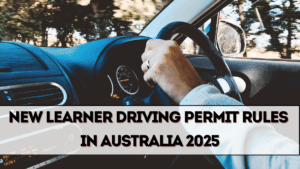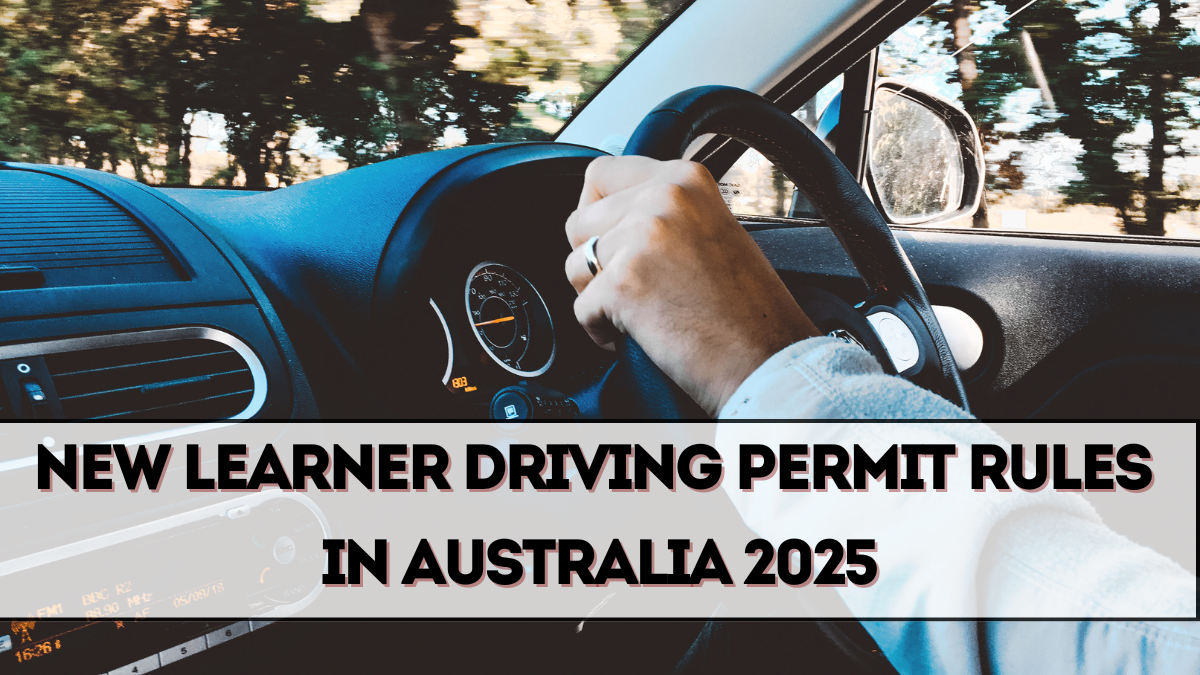Australia’s roads are set to experience important changes in 2025 with the introduction of new learner driver rules. The New Learner Permit Law 2025 updates regulations for young and first-time drivers, covering age limits, testing procedures, and probationary requirements. These updates, implemented by state transport authorities, aim to improve road safety, reduce accident risks among inexperienced drivers, and align Australia’s licensing system with international best practices.
The new framework not only impacts teenagers applying for their first learner license but also introduces stricter test rules that make the driving process more rigorous.

Why the Learner Law Has Been Updated
The decision to update the learner permit law is based on several factors:
-
Road Safety Statistics: Young drivers under 25 remain at higher risk of accidents.
-
Population Growth: More vehicles on the road require stricter training for new drivers.
-
Global Alignment: Ensuring Australian licensing standards match those of leading countries.
-
Technological Impact: Preparing learners for EVs, hybrid vehicles, and smart road systems.
With these changes, policymakers believe new drivers will be better prepared for today’s complex traffic conditions.
Key Changes in the Learner Permit Rules
The learner license 2025 rules introduce adjustments in several areas.
-
Minimum Age Requirement
-
In most states, the minimum age for obtaining a learner’s permit has been revised.
-
For example, New South Wales and Victoria now set the minimum age at 16 years and 6 months, compared to the previous 16 years.
-
This change allows slightly older learners to start, ensuring better maturity before entering traffic.
-
-
Testing Procedures
-
Learner knowledge tests now include additional modules on EV driving, eco-friendly habits, and road technology awareness.
-
Hazard perception tests have been upgraded with AI simulations, making assessments more realistic.
-
-
Supervised Driving Hours
-
The supervised driving requirement has increased in several states.
-
For example, learners in Victoria now need 130 logged hours, up from 120.
-
Night driving requirements have also been raised to ensure balanced experience.
-
-
Zero Alcohol and Drug Policy
-
A complete ban on alcohol and drugs applies to all learner drivers, with stricter penalties for violations.
-
Offenders may face immediate suspension of their learner license.
-
-
Digital L-Plates
-
Several states are piloting digital learner plates linked to apps that track compliance and road behavior.
-
This system aims to discourage learners from driving without plates.
-
How States Differ in 2025
Although learner laws in Australia follow a similar framework, each state has its own updates:
-
New South Wales: Increased supervised hours to 120 plus a mandatory hazard perception test before moving to provisional licenses.
-
Victoria: Higher night driving requirements, stricter logbook checks, and minimum age adjustment.
-
Queensland: Expanded online learning modules before sitting for the learner test.
-
Western Australia: Focus on EV driving and rural road safety in learner training.
This state-based approach ensures that the L-plate update addresses local challenges while maintaining a national safety standard.
Impact on Young Drivers
The changes mean learners in 2025 must:
-
Spend more time preparing for written and practical tests.
-
Complete additional supervised driving hours.
-
Face tougher penalties for misconduct.
-
Develop eco-friendly driving habits from the start.
While the process is longer and stricter, the end result is safer, more skilled drivers entering the road system.
Benefits of the New Rules
Authorities highlight several advantages of the updated learner license 2025 laws:
-
Lower Accident Rates: More training reduces risks among young drivers.
-
Better Prepared Drivers: Hazard simulations and stricter logbooks encourage discipline.
-
Environmental Awareness: EV and eco-driving lessons align with Australia’s green goals.
-
Technological Literacy: Learners are trained for modern vehicles with advanced features.
These benefits contribute to safer roads and a more responsible driving culture.
Challenges for Learners and Families
Despite positive goals, the law changes also bring challenges:
-
Longer Preparation: Learners may take more time to qualify for provisional licenses.
-
Higher Costs: Extra lessons and tests can increase expenses for families.
-
Digital Barriers: Not all learners have easy access to online modules or digital plates.
To address these issues, governments are offering subsidized lessons for low-income families and expanding regional testing facilities.
Preparing for the New Learner Law
Learners planning to apply in 2025 should take proactive steps:
-
Study Early: Review new modules on EVs, hazard perception, and eco-driving.
-
Logbook Discipline: Ensure every supervised hour is recorded accurately.
-
Practice Night Driving: Meet the higher requirements before final testing.
-
Stay Updated: Monitor state transport websites for regional changes.
Parents and guardians also play a critical role by supervising responsibly and emphasizing safe habits.
The Future of Learner Licensing in Australia
Looking beyond 2025, Australia’s learner system is expected to evolve further:
-
AI-Based Driver Assessments: Automated evaluation of driving behavior during supervised hours.
-
Integration with Insurance: Young drivers may earn lower premiums with better learner performance.
-
Advanced Vehicle Training: Exposure to autonomous vehicle systems as they enter the market.
-
Green Certification: Learners demonstrating eco-driving may receive incentives.
These innovations will shape the next generation of drivers, ensuring they are safer and more environmentally responsible.
FAQs
What is the new minimum age for learner permits in 2025?
In most states, the age has been adjusted to 16 years and 6 months instead of 16 years.
How many supervised hours are required under the new rules?
Victoria requires 130 hours, while other states range between 100 and 120, with additional night driving practice.
Do the new rules include EV training?
Yes, modules on electric vehicle driving and eco-friendly practices are part of the updated learner tests.
Are digital L-plates mandatory?
Not yet, but several states are trialing digital plates linked to apps for tracking learner compliance.
Click here to know more.
